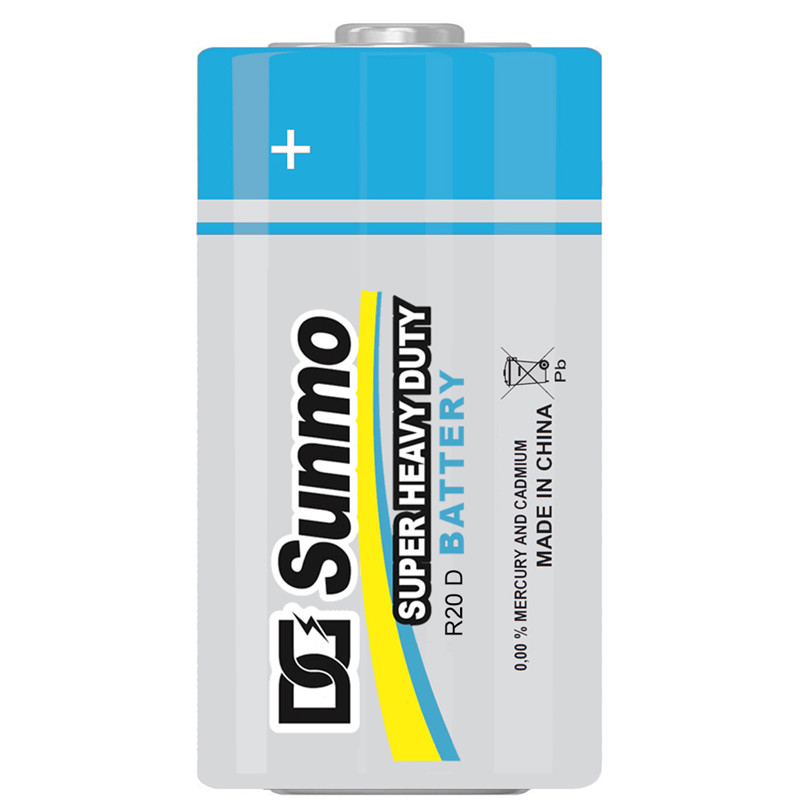| Discharge temperature: 20±2℃ | |||||
| Discharge conditions | GB/T8897.2-2008 National standard requirements | Minimum average discharge time | |||
| Discharge load | Discharge method | Termination Voltage | Within 2 months New Electricity | 12 months storage of electricity at room temperature | |
| 2.2Ω | 1h/d | 0.8 V | 5h | 7h | 6.3h |
| 10Ω | 4h/d | 0.9 V | 32h | 35h | 31.5h |
| 2.2Ω | 4m/h,8h/d | 0.9 V | 320min | 320min | 288min |
| 1.5Ω | 4m/15m,8h/d | 0.9 V | 135min | 210min | 189min |
| 3.9Ω | 1h/d | 0.9 V | 11h | 13h | 11.7h |
| 3.9Ω | 24h/d | 0.9 V | / | 700min | 630min |

As the product technology is updated and the technical parameters are adjusted, the specifications will be updated at any time, so please contact ENITA in time to obtain the latest version of the specifications.
Typical discharge curve Discharge environment: 20℃±2℃, RH60±15%
 Overview This specification specifies the technical requirements for the Anita R20P carbon zinc-manganese dry cell. If no other detailed requirements are listed, the battery technical requirements and dimensions should meet or exceed GB/T8897.1 and GB/T8897.2. 1.1 Citation standards GB/T8897.1 (IEC60086-1,MOD)(Primary battery Part 1:General) GB/T8897.2 (IEC60086-2,MOD) (Primary battery Part 2: External dimensions and technical requirements) GB8897.5 (IEC 60086-5,MOD) (Primary batteries Part 5: Safety requirements for electrolyte batteries in aqueous solution) 1.2 Environmental standards The battery complies with the EU 2006/66/EC Battery DirectiveElectrochemical system, voltage and nomenclature Electrochemical system: zinc - manganese dioxide (ammonium chloride electrolyte solution), mercury-free Nominal voltage:1.5V Name:IEC: R20P ANSI: D JIS:SUM-1 Others: 13FBattery size Battery meets sketch requirements 3.1 Acceptance tools Measured with an accuracy of not less than 0.02mm vernier calipers, measurement to prevent short-circuiting of the battery, one end of the calipers should be affixed to a layer of insulating material. 3.2 Acceptance method The use of GB2828.1-2003 normal inspection of a sampling program, special inspection level S-3, receiving quality limit AQL = 1.0
Overview This specification specifies the technical requirements for the Anita R20P carbon zinc-manganese dry cell. If no other detailed requirements are listed, the battery technical requirements and dimensions should meet or exceed GB/T8897.1 and GB/T8897.2. 1.1 Citation standards GB/T8897.1 (IEC60086-1,MOD)(Primary battery Part 1:General) GB/T8897.2 (IEC60086-2,MOD) (Primary battery Part 2: External dimensions and technical requirements) GB8897.5 (IEC 60086-5,MOD) (Primary batteries Part 5: Safety requirements for electrolyte batteries in aqueous solution) 1.2 Environmental standards The battery complies with the EU 2006/66/EC Battery DirectiveElectrochemical system, voltage and nomenclature Electrochemical system: zinc - manganese dioxide (ammonium chloride electrolyte solution), mercury-free Nominal voltage:1.5V Name:IEC: R20P ANSI: D JIS:SUM-1 Others: 13FBattery size Battery meets sketch requirements 3.1 Acceptance tools Measured with an accuracy of not less than 0.02mm vernier calipers, measurement to prevent short-circuiting of the battery, one end of the calipers should be affixed to a layer of insulating material. 3.2 Acceptance method The use of GB2828.1-2003 normal inspection of a sampling program, special inspection level S-3, receiving quality limit AQL = 1.0
| Projects | Open Circuit Voltage OCV (V) | Load voltage CCV (V) | Short circuit current SCC (A) | Sampling criteria |
| Within 2 months New Electricity | 1.60 | 1.45 | 6.0 | GB2828.1-2003 normal inspection of a sampling program, special inspection level S-4, AQL = 1.0 |
| 12 months storage of electricity at room temperature | 1.56 | 1.35 | 5.00 | |
| Test conditions | Load resistance 3.9Ω, load time 0.3 seconds, test temperature 20±2℃ | |||
| Projects | Conditions | Requirements | Qualification criteria |
| Over-discharge | Load resistance 3.9Ω at 20±2℃, humidity 60±15% discharging 1 hour per day to 0.6V termination | Visual inspection No liquid leakage | N=9 Ac=0 Re=1 |
| High temperature storage | Stored at 45±2℃, relative humidity 90%RH for 20 days |
| N=30 Ac=1 Re=2 |
| Projects | Conditions | Requirements | Qualification criteria |
| External short circuit | At 20±2℃, connect the positive and negative terminals of the battery with wires and leave it for 24 hours | No explosion | N=5 Ac=0 Re=1 |